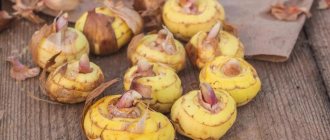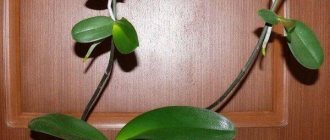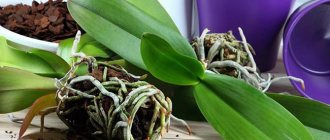There is an opinion that growing an orchid on your own is quite difficult. In fact, you just need to know the features. Compliance with them will allow you to propagate this tropical beauty at home.
The most popular method is propagation using a flower stem: several young shoots can be obtained from one.
Propagation of orchids using a peduncle
This method is called vegetative and involves dividing and rooting the stem as a whole and its parts. The method is most often used for propagating phalaenopsis, but the method is also suitable for other varieties.
How to choose the right time
To grow an orchid from a peduncle, you will need to wait until the tropical beauty fades. This period is optimal for starting the procedure. Coincidence with the arrival of spring on the calendar doubles the chances of success.
Preparation
The stem is cut and divided into parts.
Each fragment of the peduncle must contain a living bud.
The necessary conditions
There are often cases when an orchid does not produce new shoots for a long time, and the peduncle does not produce children. The explanation is simple: favorable conditions are not created for the plant. In order for an orchid to have lateral shoots, it is necessary, first of all, for it to be healthy. Before breeding, visually inspect the tropical beauty: there should be no yellow or black spots on it.
Among the mandatory conditions for breeding are also:
- the humidity level is within 50-80%, for which the container with the peduncle is placed in a tray with expanded clay and water. Another way is to spray with warm water.
- temperature regime (+28..+30), which can be exceeded, but not reduced;
- diffuse lighting should be less intense;
- feeding the plant with nitrogen fertilizer.
Classification by growth type
All types of orchids, according to their characteristic growth characteristics, are divided into two large groups:
- Sympodial - plants consist of numerous shoots that are connected to each other by a rhizome. This is a modified stem creeping along the surface of the substrate, from the nodes of which leaves and pseudobulbs with bunches of young roots are formed. They have several growth points, and each new shoot turns into a pseudobulb (a thickened orchid stem with a supply of nutrients). This type includes “lelia”, “cattleya”, “dendrobium”.
- Monopodial - they do not have rhizomes or pseudobulbs, but contain one vertical stem and only one apical growing point. Growth is accomplished by lengthening the stem and laying leaves at the top. Buds are formed in the axils, between the leaves. From them lateral peduncles or axillary aerial roots are formed. Over time, the leaves below grow old and die, and young ones develop higher up the shoot. Representatives of this type are “phalaenopsis” and “vanda”.
Its method of reproduction depends to some extent on the type of orchid it belongs to.
Awakening a sleeping bud
The process occurs in the active phase of flower growth. There are several ways to push a sleeping kidney to awaken.
Since the main factor is a high level of humidity, so that babies sprout from the buds faster, the flower stalk is placed in a mini-greenhouse. It is made from an ordinary plastic bottle. About half of it is cut horizontally, leaving about 2 cm to hold the parts together. Water is poured into the lower half and a peduncle is placed. Then it is closed with the top of the bottle and secured with tape. To allow air to enter the “greenhouse”, the lid is not screwed on.
To grow an orchid from a peduncle, you can plant it in a plastic container to awaken the buds. Sphagnum moss is placed at the bottom of it, on which parts of the stem with one living bud are placed. The container needs a lid: it will create the desired level of humidity.
In a bottle
Another option for propagating an orchid using a plastic container. Only the neck of the bottle is cut off. Then water is poured into it to a level of 6 cm and the peduncle is lowered. The kidney should be on the surface.
The greenhouse is placed in a place well illuminated by diffused sunlight, but so that the future plant is not touched by the direct rays of the heavenly body. Protect against rotting of the bottom of the peduncle by adding activated carbon to the water. Periodically you need to feed with fertilizer containing nitrogen.
Transplantation to a permanent place
The reason for transplantation is the appearance of roots on the peduncle. The future orchid is ready for transplantation when they reach a length of 50 mm. The pot in which the plant will grow further must be filled with a suitable substrate. The ratio of its composition:
- 1 part – charcoal;
- 1 part – sphagnum moss;
- 5 parts – evaporated pine bark, the diameter of the fractions is 1 cm.
And expanded clay is placed at the very bottom of the pot.
If you have doubts about the ability to prepare the substrate in the correct ratio, it is better to buy a ready-made mixture in the store. This will increase the likelihood of successfully growing an orchid from a peduncle stem at home.
What is a flower shoot?
During the flowering period, the orchid produces a peduncle - a long straight shoot directed upward or towards the light. It is on it that buds are formed, which subsequently bloom into wonderful flowers, which are the main pride of this plant.
At the initial stages, it is almost impossible to distinguish a peduncle from an aerial root ; both begin to grow at the junction of the leaf and the trunk, and look almost the same. The difference becomes obvious when the process reaches a length of several centimeters.
Caring for a plant to produce babies
When the orchid fades and falls off, shoots may appear on the flower stalk. Babies, as flower growers affectionately call them, are easily separated and rooted from the mother orchid, as they are a miniature but fully formed plant. The shoot has a stem, leaves and roots.
Proper care will help stimulate the appearance of babies on the stem of the peduncle to make it easier to grow an orchid at home. The following recommendations will help you not to ruin a young plant:
- water after replanting as the moss dries;
- ventilate the greenhouse every day;
- replant only after an adaptation period, which should take place gradually;
- Use only soil for orchids.
How to get young plants using green cuttings
Step-by-step instruction
This method of propagation is most popular because it is simple, and young plants can be rooted as many as there are buds on a faded shoot.
For work you need to prepare the following devices and materials:
- Cutting tool - a knife with a sharp blade, a surgical scalpel or garden pruning shears;
- Disinfecting solution for instrument treatment. Typically, ethyl alcohol or chlorhexidine is used;
- To apply the product, you need a cotton swab or soft natural fabric ;
- Cutting agent . For this purpose, choose one of the following substances:
- Powdered charcoal or activated carbon,
- Finely ground cinnamon.
- Rooting stimulator , for example, “Kornevin” or a similar drug.
- Greenhouse for rooting cuttings . It is constructed from an ordinary plastic cylinder. In the upper part of the container, approximately 1/3 of the height, an incision is made so that the lid can be opened slightly. A layer of sand or sphagnum moss is placed on the bottom. Before planting the cuttings, the nutrient substrate is moistened. When closed, so that the “lid” fits tightly, it is attached with tape or adhesive tape.
When everything is ready, you can begin the main process.
Step-by-step instruction
| Step 1 | Move the phalaenopsis to the desktop and place it so that it is convenient to work with the plant. |
| Step 2 | Using a cotton swab or soft cloth soaked in alcohol (or chlorhexidine), wipe the blade of the cutting tool. |
| Step 3 | Cut off the flower stalk from the main stem. |
| Step 4 | Cut the stem into pieces so that each fragment has a dormant bud. Moreover, the lower end under the kidney should be longer than above it. Leave at least two centimeters at the bottom and 0.5 cm at the top. |
| Step 5 | Dry the upper cuts of the cuttings and treat them with a protective agent, charcoal or cinnamon. |
| Step 6 | Prepare a rooting agent solution. For example, the hormonal drug “Kornevin” is used to soak orchid cuttings. It contains indolylbutyric acid (IBA), which stimulates callus formationnecessary for the growth of new roots. Specialist consultation Callus are specific plant cells that form connective tissue for healing open wounds. Based on the article "Callus plants" author – E. V. Lyapustina, Candidate of Biological Sciences. To germinate roots from green orchid cuttings, prepare a solution in the following proportion: · Kornevina – 1 g. · Water – 1 l. Keep the cuttings in the solution for 8-10 hours. You don’t have to soak the cuttings, but just dip the bottom cut in the powder and immediately place it in a damp substrate. |
| Step 7 | Plant the prepared cuttings in a greenhouse. To avoid damaging the delicate stems, use a pencil to make indentations in the substrate. Insert green cuttings treated in the rooting agent into them. Then, squeeze the substrate around them with two fingers.
|
| Step 8 | Cover the greenhouse with the upper cut part and secure it with tape or adhesive tape. Construction tape will also work. |
| Step 9 | Place the structure in a warm, bright place. Inspect the inside of the greenhouse daily. Control the temperature, which should correspond to the indicators – +240 – +280, and humidity, within 70 – 80%. You also need to constantly ventilate the container; to do this, just open the lid. Air stagnation should not be allowed, otherwise the cuttings will rot. For the survival of the cuttings, the moisture that accumulates inside the greenhouse is sufficient. Therefore, watering is carried out rarely, on average once every two weeks. |
3.Rooting green orchid cuttings in a greenhouse from a plastic balloon.
If everything is done correctly, the bud on the cutting will begin to germinate in about two weeks. In fact, the same baby is formed as on the growing shoot. First, two leaves grow. At the same time, new roots are formed. When they grow to three or four centimeters, the young plant can be planted in a separate pot in an orchid substrate.
Stimulation: use of cytokinin paste
The maximum benefit for using the drug, created on the basis of the phytohormone of the same name, is achieved with proper application. To do this, a dense scale is cut on the uppermost or lower dormant bud. You can use a knife, needle, scalpel (pre-disinfect). Remove the cut off scale and apply a ball of paste with a diameter of 2 mm to the opened green dot (this is the bud). Spread over the surface of the kidney.
With the correct process, the result will be noticeable after 7-10 days.
Baby separation technology
In order not to sigh sadly about why you can’t grow an orchid from a peduncle at home, you should follow simple rules:
- the flowering stem is cut off at the base;
- Each part when divided must have a bud;
- the length of one cutting is 4-5 cm;
- the bud should be located in the center of the piece.
Pros and cons of this propagation method
Growing an orchid from a peduncle at home is the most reliable and safe method of propagation. Among the advantages, flower growers note:
- safety of the mother orchid;
- a fairly large percentage of plants take root;
- the ability to stimulate the awakening of the kidneys;
- Even an inexperienced lover of tropical plants can master it.
But difficulties may also arise. Due to inexperience, a weak plant will be used for propagation: a young plant instead of an adult one, without a healthy root system, or an unsuitable peduncle. In addition, the breeding period was chosen incorrectly. All these nuances must be taken into account.
Main problems
When propagating and growing orchids, gardeners are faced with situations related to growth and reproduction. Let's look at the most common problems.
Does not produce a peduncle
The reason is regular watering. To eliminate, it is necessary to create arid conditions:
- increase the break between watering;
- leave for another 4-7 days without water;
- ensure the air temperature does not exceed +30 degrees;
- do not spray;
- do not feed.
Children are not educated
A shoot appears when the plant is exposed to unfavorable conditions. What to do? Water less when temperatures and humidity are high. Or use a stimulating agent - cytokinin paste.
The emerging shoot has dried up
Delete. There are other dormant buds that create the necessary conditions for development. You can stimulate as described above.
The roots of a young plant died
Don't rush to throw it away. The following procedure will contribute to the appearance of new roots:
- Place sphagnum moss in water and let it swell;
- form it into a ball and fasten it with thread;
- attach the resulting lump to the base of the process;
- Spray the moss daily with water with the addition of Kornevin.
Is it possible to propagate a flower?
It is indeed possible to propagate an orchid at home, especially since the characteristics of this crop suggest several ways to obtain a new plant. So, you can simply divide an adult bush into several young plants, or use children or cuttings for this purpose.
In addition, the crop can be grown from seeds, but this method is much more complicated and is suitable only for those who want to master all stages of growing a crop.
When is the best time to propagate?
It is best to begin the propagation procedure one to two months after flowering has completed. The same time is also suitable for replanting a flower, since at this time the crop enters a period of vegetative dormancy and you can easily divide the bush or cut the required number of cuttings.
Unlike transplantation, which, if necessary, can be carried out with a flowering crop (for example, if pests have settled on the plant), it is better to postpone propagation until spring so that the adult plant does not experience stress from the procedure.











